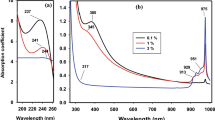Abstract
This paper reports on the results of the investigation of KGSS 0180/35 neodymium phosphate glasses produced on an industrial scale under oxidizing conditions and glasses prepared under experimental conditions in which iron and copper in small amounts rather than neodymium are introduced into the glass composition. The experimental glasses are synthesized by varying the redox conditions of melting. The oxidation states of transition metal impurities (Cu, Fe, V, Ni, Co) and the nonactive absorption coefficients of glasses at the lasing wavelength are determined. It is revealed that the main contribution to the nonactive absorption coefficient of the KGSS 0180/35 glass produced on an industrial scale is made by Cu2+ ions at a concentration higher than 0.5 ppm. At a lower copper concentrations, the total contribution of Fe2+, V4+, Ni2+, and Co2+ impurity ions to the nonactive absorption coefficient is comparable to that of Cu2+ ions. It is demonstrated that a decrease in the concentration of coloring impurities in glasses and the optimization of redox conditions of melting make it possible to prepare phosphate laser glasses with a nonactive absorption coefficient of the order of 0.001 cm−1. In terms of the nonactive absorption coefficient, these glasses are on a par with similar glasses of foreign manufacture and satisfy the requirements imposed on glasses by developers of high-power high-energy laser facilities.
Similar content being viewed by others
References
Arbuzov, V.I., Volynkin, V.M., Lunter, S.G., et al., Large-Sized Disc-Shaped Active Elements Made from Neodymium Phosphate Glass for High-Power High-Energy Lasers, Opt. Zh., 2003, vol. 70, no. 1, pp. 68–78.
Campbell, J.H. and Suratwala, T.I., Nd-Doped Phosphate Glasses for High-Energy/High-Peak-Power Lasers, J. Non-Cryst. Solids, 2000, vols. 263–264, pp. 318–341.
Ageeva, L.E., Brachkovskaya, N.B., Lunter, S.G., Przhevuskii, A.K., and Tolstoi, M.N., Determination of the Stimulated Emission Cross Section of Neodymium Glasses by Measurement of the Absorption from the Thermally Populated 4 I 11/2 Levels, Kvantovaya Elektron. (Moscow), 1977, vol. 7, no. 11, pp. 2414–2420.
Ehrman, P.R., Campbell, J.H., Suratwala, T.I., Hayden, J.H., Krashkevich, D., and Takeuchi, K., Optical Loss and Nd3+-Non-Radiative Relaxation by Cu, Fe, and Several Rare Earth Impurities in Phosphate Laser Glasses, J. Non-Cryst. Solids, 2000, vols. 263–264, pp. 251–262.
Toratani, H., Meissner, H.E., Izumitani, T., and Sokowski, S.E., Phosphate Laser Glass at Absorption Loss of 10-4 cm-1, J. Non-Cryst. Solids, 1987, nos. 95–96, pp. 701–708.
Zirkelbach, K. and Brückner, R., Spectroscopic Investigations of Barium Aluminophosphate Glasses Containing Vanadium, Iron, and Manganese Oxides, Glastech. Ber., 1987, vol. 60, pp. 312–323.
Pivac, B., Moguš-Milancović, A., and Day, D.E., Iron Valence and Coordination in Phosphate Glasses as Studied by Optical Spectroscopy, J. Non-Cryst. Solids, 1998, vol. 226, pp. 41–46.
Bae, B.S. and Weinberg, M.C., Oxidation-Reduction Equilibrium in Copper Phosphate Glass Melted in Air, J. Am. Ceram. Soc., 1991, vol. 74, no. 12, pp. 3039–3045.
Arbuzov, V.I., Vakhmyanin, K.P., Polynkin, V.M., et al., Absorbing Coatings for Large-Sized Disc-Shaped Active Elements from Neodymium Phosphate Glass KGSS0180/35 for Laser Amplifiers, Opt. Zh., 2002, vol. 69, no. 1, pp. 16–20.
Ehrman, P.R. and Campbell, J.H., Nonradiative Energy Losses and Radiation Trapping in Neodymium-Doped Phosphate Laser Glasses, J. Am. Ceram. Soc., 2002, vol. 85, no. 5, pp. 1061–1069.
Demkina, L.I., Nauchno-tekhnicheskie osnovy proizvodstva opticheskogo stekla s malym pokazatelem oslableniya (Scientific and Technical Principles for Manufacturing of Optical Glass with a Small Attenuation Coefficient), Leningrad: GOI, 1982.
Veinberg, T.I., Absorption Spectra of Vanadium in Phosphate Glasses, Opt.-Mekh. Prom-st., 1958, no. 9, pp. 46–51.
Veinberg, T.I., Coloration of Phosphate Glasses, Tr. Gos. Opt. Inst., 1963, vol. 31, no. 160, pp. 224–236.
Author information
Authors and Affiliations
Additional information
Original Russian Text © P.E. Gusev, V.I. Arbuzov, M.V. Voroshilova, S.I. Nikitina, A.D. Semenov, Yu.K. Fedorov, 2006, published in Fizika i Khimiya Stekla.
Rights and permissions
About this article
Cite this article
Gusev, P.E., Arbuzov, V.I., Voroshilova, M.V. et al. Effect of coloring impurities on the absorption in neodymium phosphate laser glass at a lasing wavelength. Glass Phys Chem 32, 146–152 (2006). https://doi.org/10.1134/S1087659606020040
Received:
Issue Date:
DOI: https://doi.org/10.1134/S1087659606020040




